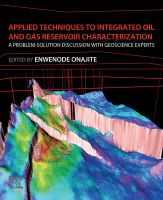Browse content
Table of contents
Actions for selected chapters
- Full text access
- Book chapterNo access
Advice from the industry: career guide to geosciences students and how to prepare for interview
Pages 407-411 - Book chapterNo access
Index
Pages 413-421
About the book
Description
Over the past several years, there has been a growing integration of data – geophysical, geological, petrophysical, engineering-related, and production-related – in predicting and determining reservoir properties. As such, geoscientists now must learn the technology, processes, and challenges involved within their specific functions in order to optimize planning for oil field development.
Applied Techniques to Integrated Oil and Gas Reservoir Characterization presents challenging questions encountered by geoscientists in their day-to-day work in the exploration and development of oil and gas fields and provides potential solutions from experts. From basin analysis of conventional and unconventional reservoirs, to seismic attributes analysis, NMR for reservoir characterization, amplitude versus offset (AVO), well-to-seismic tie, seismic inversion studies, rock physics, pore pressure prediction, and 4D for reservoir monitoring, the text examines challenges in the industry as well as the techniques used to overcome those challenges.
This book includes valuable contributions from global industry experts: Brian Schulte (Schiefer Reservoir Consulting), Dr. Neil W. Craigie (Saudi Aramco), Matthijs van der Molen (Shell International E&P), Dr. Fred W. Schroeder (ExxonMobil, retired), Dr. Tharwat Hassane (Schlumberger & BP, retired), and others.
Over the past several years, there has been a growing integration of data – geophysical, geological, petrophysical, engineering-related, and production-related – in predicting and determining reservoir properties. As such, geoscientists now must learn the technology, processes, and challenges involved within their specific functions in order to optimize planning for oil field development.
Applied Techniques to Integrated Oil and Gas Reservoir Characterization presents challenging questions encountered by geoscientists in their day-to-day work in the exploration and development of oil and gas fields and provides potential solutions from experts. From basin analysis of conventional and unconventional reservoirs, to seismic attributes analysis, NMR for reservoir characterization, amplitude versus offset (AVO), well-to-seismic tie, seismic inversion studies, rock physics, pore pressure prediction, and 4D for reservoir monitoring, the text examines challenges in the industry as well as the techniques used to overcome those challenges.
This book includes valuable contributions from global industry experts: Brian Schulte (Schiefer Reservoir Consulting), Dr. Neil W. Craigie (Saudi Aramco), Matthijs van der Molen (Shell International E&P), Dr. Fred W. Schroeder (ExxonMobil, retired), Dr. Tharwat Hassane (Schlumberger & BP, retired), and others.
Key Features
- Presents a thorough understanding of the requirements of various disciplines in characterizing a wide spectrum of reservoirs
- Includes real-life problems and challenging questions encountered by geoscientists in their day-to-day work, along with answers from experts working in the field
- Provides an integrated approach among different disciplines (geology, geophysics, petrophysics, and petroleum engineering)
- Offers advice from industry experts to geoscience students, including career guides and interview tips
- Presents a thorough understanding of the requirements of various disciplines in characterizing a wide spectrum of reservoirs
- Includes real-life problems and challenging questions encountered by geoscientists in their day-to-day work, along with answers from experts working in the field
- Provides an integrated approach among different disciplines (geology, geophysics, petrophysics, and petroleum engineering)
- Offers advice from industry experts to geoscience students, including career guides and interview tips
Details
ISBN
978-0-12-817236-0
Language
English
Published
2021
Copyright
Copyright © 2021 Elsevier Inc. All rights reserved.
Imprint
Elsevier
